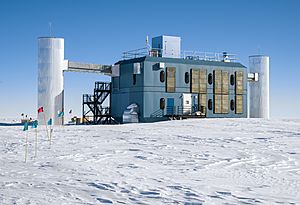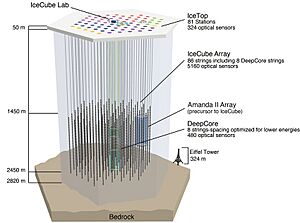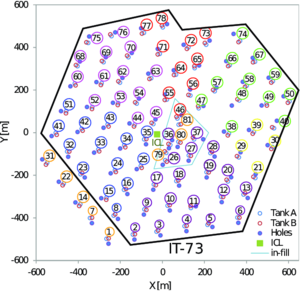IceCube Neutrino Observatory facts for kids
Quick facts for kids IceCube Neutrino Observatory |
|||||
|---|---|---|---|---|---|

IceCube Neutrino Observatory at the South Pole
|
|||||
| Organization | IceCube collaboration | ||||
| Location | Amundsen–Scott South Pole Station | ||||
|
Coordinates
|
89°59′24″S 63°27′11″W / 89.99000°S 63.45306°W
|
||||
|
|||||
The IceCube Neutrino Observatory, or just IceCube, is a special neutrino detector built at the Amundsen–Scott South Pole Station in Antarctica. It's like a giant telescope, but instead of light, it looks for tiny particles called neutrinos. This project is a recognized experiment by CERN, a famous science organization.
IceCube has thousands of sensors hidden deep under the Antarctic ice. These sensors are spread out over a huge area, about one cubic kilometre (which is like a cube 1 kilometer long, 1 kilometer wide, and 1 kilometer high!).
Like an older project called AMANDA, IceCube uses round sensors called Digital Optical Modules (DOMs). Each DOM has a special light sensor called a photomultiplier tube (PMT). It also has a small computer that collects data. This data is then sent to a control building on the surface. IceCube was finished on December 18, 2010.
Scientists put the DOMs into the ice using hot water drills. They are placed on long strings, with 60 modules on each string. These strings go deep into the ice, from 1,450 to 2,450 meters down. IceCube's main goal is to find where high-energy neutrinos come from. This helps scientists learn about powerful events in space.
In November 2013, scientists announced that IceCube found 28 neutrinos. These neutrinos likely came from outside our Solar System.
Contents
How was IceCube Built?
IceCube is a project led by the University of Wisconsin–Madison. Many other universities and research groups from around the world helped build it and provided money. Building IceCube was only possible during the Antarctic summer. This is from November to February, when the sun shines all day and night. This allowed drilling to happen 24 hours a day.
Construction started in 2005. The first string of sensors was put into the ice. Data from these sensors showed that they worked correctly. In the 2005–2006 season, eight more strings were added. This made IceCube the biggest neutrino telescope in the world at that time.
| Season | Strings Installed | Total Strings |
|---|---|---|
| 2005 | 1 | 1 |
| 2005–2006 | 8 | 9 |
| 2006–2007 | 13 | 22 |
| 2007–2008 | 18 | 40 |
| 2008–2009 | 19 | 59 |
| 2009–2010 | 20 | 79 |
| 2010 | 7 | 86 |
Building IceCube was completed on December 17, 2010. The whole project cost about $279 million.
What are IceCube's Parts?
The IceCube Neutrino Observatory has several parts, not just the main sensors in the ice.
- AMANDA: This was the first part built. It proved that the idea for IceCube would work. AMANDA was turned off in May 2009.
- IceTop: This part is a group of detectors on the surface of the ice. Two detectors are placed above each IceCube string. IceTop helps study cosmic rays. It also checks if particles seen on the surface match those seen deep in the ice. If a particle goes through IceTop, it means it's not from a neutrino interacting in the ice.
- Deep Core Low-Energy Extension: This is a special area within IceCube with more sensors packed closely together. It helps detect lower energy neutrinos, below 100 GeV. The Deep Core strings are in the center of the main IceCube array. They are placed deep in the clearest ice, between 1760 and 2450 meters down.
Scientists have also suggested new parts for IceCube. PINGU (Precision IceCube Next Generation Upgrade) would help detect even lower energy neutrinos. This could help figure out the mass of neutrinos. A much bigger observatory, called IceCube-Gen2, has also been imagined.
How Does IceCube Work?
Neutrinos are tiny particles that have no electric charge. They almost never interact with other matter. But sometimes, when a neutrino hits a water molecule in the ice, it can create another charged particle. These charged particles can then give off light. This light is called Cherenkov radiation. It happens when the charged particle travels through the ice faster than light can travel through the ice. It's similar to how a boat creates a "bow shock" wave when it moves faster than the water waves.
The special light sensors (PMTs) inside the DOMs detect this light. The signals from the PMTs are turned into digital data. This data is then sent up to the surface building through cables. Some of this data is sent north by satellite for scientists to study. Since 2014, most of the data is stored on hard drives. These hard drives are sent north once a year by ship.
Once scientists have the data, they can figure out where the neutrino came from. High-energy neutrinos create a strong signal in the detector. This signal can point back to their origin. If many neutrinos seem to come from the same spot, it could mean there's a "point source" of neutrinos there.
IceCube is best at finding high-energy neutrinos. It can detect them in a range from 107 to about 1021 eV.
IceCube is especially good at finding muons. Muons are charged particles that can travel very far through the ice. This means IceCube is very sensitive to muon neutrinos. Other types of neutrinos, like electron neutrinos, create more scattered, "cascade-like" events. Muon neutrinos create more straight, "track-like" events.
There's a lot of "background noise" from muons created by cosmic rays hitting Earth's atmosphere. These cosmic ray muons are much more common than neutrinos from space. Most of these can be ignored because they travel downwards. Most of the remaining particles that travel upwards are from neutrinos. Some of these neutrinos come from cosmic rays hitting the other side of Earth. But some also come from distant stars and galaxies. These are the ones IceCube is looking for. Scientists expect to find about 75 upward-moving neutrinos each day. By mapping where these neutrinos come from, IceCube helps us understand the universe.
What are IceCube's Main Goals?
Finding Point Sources of High-Energy Neutrinos
Finding where high-energy neutrinos come from could help solve a big mystery: where do the highest-energy cosmic rays come from? These cosmic rays are so powerful that they can't be held by our galaxy's magnetic fields. So, scientists think they come from outside our galaxy. Very powerful events in space that create these cosmic rays would also likely create high-energy neutrinos. Neutrinos can travel to Earth without being bent or stopped. IceCube can detect these neutrinos.
IceCube is better at finding point sources in the northern sky than in the southern sky. This is because cosmic ray muons can hide the signals from the southern sky. So, early searches focused on the northern sky.
Even though IceCube finds very few neutrinos compared to regular telescopes that see light, it can pinpoint their origins very well. Over several years, it could create a map of the northern sky based on neutrinos. This would be like maps made by gamma-ray telescopes.
Scientists may have detected their first neutrinos on January 29, 2006.
Looking for Gamma-Ray Bursts with Neutrinos
When particles called protons crash into each other or into photons (light particles), they often create other particles. Some of these particles decay into neutrinos and gamma rays. Scientists think that neutrinos and gamma rays might come from the same sources, like gamma-ray bursts or supernova remnants. This would help explain where these powerful events come from.
IceCube works with gamma-ray satellites like Swift and Fermi to look for these matching signals. So far, IceCube has not seen any neutrinos at the same time as gamma-ray bursts. But this search helps scientists set limits on how many neutrinos these events might produce.
Searching for Dark Matter
Scientists think there's a mysterious substance called dark matter in the universe. Some types of dark matter particles, called WIMPs, could be trapped by the Sun's gravity. If enough WIMPs gather in the Sun's core, they might crash into each other and disappear. When they disappear, they could create neutrinos. IceCube could then detect these neutrinos coming from the Sun. This is called an "indirect" search for dark matter. IceCube has already set better limits on WIMPs than previous experiments.
Studying Neutrino Oscillations
Neutrinos can change from one type to another as they travel. This is called neutrino oscillation. IceCube can observe these changes in neutrinos that come from cosmic rays hitting Earth's atmosphere. The DeepCore part of IceCube is especially good at this. In 2014, data from DeepCore helped scientists measure how much neutrinos change. As more data is collected, IceCube might even be able to figure out the "neutrino mass hierarchy." This means understanding the order of the different neutrino masses.
Detecting Galactic Supernovae
Even though neutrinos from a supernova are usually too low in energy for IceCube, it could still detect a supernova that happens close by (within our own galaxy). A supernova would appear as a sudden, short increase in noise across the entire detector. IceCube is part of the Supernova Early Warning System (SNEWS). This system alerts scientists around the world when a supernova is detected.
Looking for Sterile Neutrinos
Some theories suggest there might be another type of neutrino called a sterile neutrino. If sterile neutrinos exist, they would change the energy pattern of atmospheric neutrinos. IceCube is in a unique position to look for this change. This could even provide evidence for extra dimensions, which are predicted by some theories like string theory.
In 2016, scientists at IceCube did not find any evidence for sterile neutrinos.
What Has IceCube Discovered?
The IceCube team has published many findings. They have set limits on neutrinos coming from point sources, gamma-ray bursts, and dark matter disappearing in the Sun.
They also observed a "shadowing effect" from the Moon. The Moon blocks cosmic ray protons, which creates a small dip in the number of cosmic ray muons coming from the Moon's direction.
In 2013, IceCube detected two very high-energy neutrinos. They were nicknamed "Bert and Ernie" after characters from the TV show Sesame Street. These were the highest-energy neutrinos found at that time. Later in 2013, an even more energetic neutrino was found and named "Big Bird".
In 2014, IceCube measured how atmospheric muon neutrinos disappear. This helped them understand neutrino oscillation parameters.
In July 2018, IceCube announced a major discovery. They traced an extremely high-energy neutrino that hit their detector in September 2017. It came from a blazar called TXS 0506 +056, located 5.7 billion light-years away in the constellation Orion. This was the first time a neutrino detector was used to find an object in space. It showed that a source of cosmic rays had been identified.
In 2020, scientists found evidence of the Glashow resonance. This is a special event where a W boson particle is formed when an antineutrino hits an electron.
In February 2021, IceCube reported a possible detection of a tidal disruption event (where a star gets torn apart by a black hole). A second possible event was reported in June 2022.
In November 2022, IceCube announced finding a neutrino source from the center of Messier 77, a galaxy. This is only the second source IceCube has found, after TXS 0506+056. Only a few other neutrino sources are known, like SN1987A and solar neutrinos.
See also
 In Spanish: IceCube para niños
In Spanish: IceCube para niños
- Antarctic Muon And Neutrino Detector Array
- Radio Ice Cherenkov Experiment
- ANTARES and KM3NeT, similar neutrino telescopes using deep-sea water instead of ice.
- Multimessenger astronomy




